#i wish i could see a snapshot of where i am artistically in 10 years
Text
ppl who have actual ideas for the art they make are so fucking strong i’m so envious
#i feel like i’ve had maybe 3 ideas total#i think i’m pretty decent at art. i like my art often. but it all feels like it’s vaguely nothing. substanceless#i’m fairly good at making pretty pictures i think but it feels like that’s all it is#i’m honestly not that creative i don’t have a lot of ideas often#hellish because the interesting ideas that i do have are locked in my brain behind barriers of lack of skill and motivation#i can only make art when it’s easy or when i’m really really passionate#but the things that i need to be able to do to create the things i want to are very difficult and i do not want to do them#thus i am stuck#i like drawing. i do. but the things i’d need to do to actively improve are unreachable#and stagnation is so frustrating#art should be fun first and foremost but it’s not fun when i’m bad at it and it’s not fun when i’m trying to learn it actively#so the things that are fun are vaguely nothing shaped.#HELL. art is hell i love it it’s killing me i wish i could put it down forever and also i’d rather die than stop drawing forever#i wish i could see a snapshot of where i am artistically in 10 years#i also don’t cause then the next ten years would be agonizing and depending on the kind of time travel rules i’d definitely create a paradox#ultimately there is nothing to do except keep drawing. how fucked up is that
1 note
·
View note
Text
CW Star Jensen Ackles Invites AD Inside His Family Home in Austin
Jensen and his wife, Danneel, worked with a local Austin team to devise a lakeside home with tongue-in-cheek touches and a musical through line

Kathryn Romeyn
NOVEMBER 27, 2018 10:30 AM
There’s a lot going on inside the Lake Austin home of actors Jensen and Danneel Ackles—a lot of color, a lot of texture, endless elements begging their stories to be told. If you need a quick snapshot: The living room is scattered with guitars and, on the shag rug, Technicolor floor pillows; antique Venetian dioramas of Lilliputian-sized rooms are embedded into the white-oak walls, while a hanging cage traps gilded Barbie dolls by Micky Hoogendijk; on top of a shelf housing a record player, a photograph of Tom Waits sits next to a chicken skeleton; a regal white peacock perches on the side of the mercantile-style bar. There’s the master bedroom swaddled in Trove wall covering bearing vintage photography of 1920s opera boxes. And the two-story screened-in porch holds a table crafted from a 2,000-year-old cypress sinker log, a storied Boyd Elder cow skull, and four-foot glass lanterns from Tony Duquette’s estate.Indeed, Danneel and Duquette share a similar philosophy. “More is more is more!” Danneel says emphatically. “More is the most.” Still, the Ackleses' five-bedroom, 7,500-square-foot residence isn’t actually an ode to opulence but rather an evocative tribute to key passions at the core of their personalities: the music and aesthetics of the late ’60s, Austin’s art scene, and imaginative oddities and occultist ephemera, perhaps appropriate considering Jensen’s longtime role on the CW’s Supernatural.After deciding to leave Brentwood, California, and coming this close to putting in an offer on a Lake Austin fixer-upper, the couple set their gaze on a house three doors down, sans “for sale” sign. “As we drove by, Danneel and I both looked at our real estate agent and were like, ‘See, that is the kind of house we’re looking for,’” recalls Jensen. Adds Danneel, “we wanted something less ostentatious.” Fortunately, the owner was willing to sell, but the property was far from turnkey and required an overhaul to go from what Danneel calls the “Texas Tuscan look"—generic stuccoed track mansion—to a wood-clad ranch-style stunner.
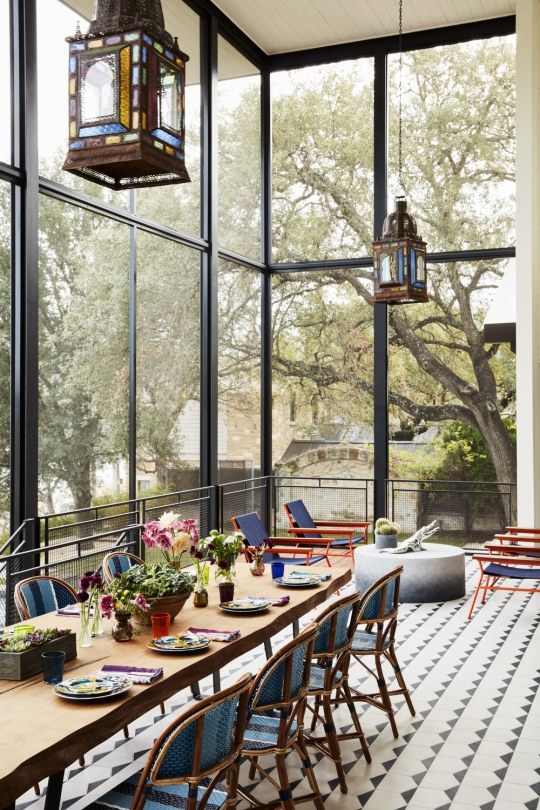
Danneel, a Tony Duquette superfan, was over the moon when Santini brought the stained glass pendants she’d bought from his estate. Photo: Douglas Friedman

The slightly sunken living room with the deep blue banquette couch, white shag rug, macrame chair, and muscular oak beams is Jensen’s favorite space.Photo: Jeff Wilson
Jensen and Danneel enlisted Austin architect Paul Lamb and Abode principal interior designer Fern Santini to kickstart what ended up being a very collaborative renovation—even the Ackleses' eldest child, five-year-old JJ, got into the fun, choosing everything in her Pinterest-worthy bedroom. At their initial meeting with Santini, the potential for partnership was evident when she pulled up in an auspicious 1967 E-Type Jaguar. “I mean, it’s just like the coolest thing ever,” says Jensen of the car, which was made in the same year Danneel had said she wanted to recreate in the Austin home so as to pay tribute to the Laurel Canyon bungalow where the couple once lived. “People like Carly Simon had played guitar there,” Danneel says. “It was a magical little place. So when Fern pulls up in that car ... We just bonded over music and a love of that time period and had our vision right off the bat.”
Executing that vision involved blowing out the majority of the house’s interior, taking it down to the studs, and reconfiguring it. “It was very closed and very ‘90s,” says Santini. Extensive structural work was devised by Lamb, one of Santini's frequent creative conspirator. “Paul is from New Orleans and I’m from Louisiana, and we have the same odd sense of humor and style,” says Danneel, who saw a residential elevator he’d done entirely in red velvet and said, “That’s the guy for me!” The foursome worked beautifully together—that is, after Jensen learned early on to keep his mouth shut if and when he doubted any stylistic choices. When shown the idea for a rich, royal blue sofa, “I was like, ’Y’all are crazy!’” says Jensen. “But then I just thought, I’m not going to get in their way.”
Smart man, considering a highly personalized space began to unspool under Santini and Lamb's direction. “It was imperative that the house express the Ackleses—young, bold, and irreverent,” Lamb says. “It had to be full of humorous and endearing eccentricities and it needed to radiate a comforting yet exotic familiarity.” He simplified and opened spaces, flipped the feel from a masonry house to a wood-framed home—thanks to exposed beams, larger expanses of windows, and rich wooden ceilings—and, perhaps most transformational, added a breezy two-story screened porch that altered the entire profile. “The former house was straight-laced and vaguely Mediterranean,” Lamb says. “Now it is an eclectic, free-spirited, Austin-style lake house.” Santini calls it “a cross between Joni Mitchell and the Serge Gainsbourg–Jane Birkin thing that was going on in Paris at the same time. It’s very hip but it’s low-key.”
Musically, the home is rich with sound, thanks to Jensen’s collection of guitars and the McIntosh turntable Santini says she “has real fetish for, after spending my entire career trying to hide stereo equipment.” There’s also a surfeit of historical and meaningful music-related artwork—think photographs of Yasgur’s Farm in Woodstock and a house where Bob Dylan recorded. “The hand-scraped wood floors undulate quite heavily, and we’ve got these giant beams and wood all around that feel like you’re in the hull of a giant ship,” Jensesn says. “What that does is it creates an amazing acoustic sound. We’ve always had music in our lives, and we wanted to pass on that tradition.”
The parents of three also are active supporters of local art. “We’re not the type who need it to all be the same. That’s criminal to me, almost,” says Danneel of their home full of diverse pieces from Austin and Marfa, including female artists from galleries like Women and Their Work. Santini describes the pair as risk-takers who both led the charge on outside-the-box thinking and let her push the limits. In their third home together, the Ackleses hit their stride, nailing a personally reflective infusion of edge, humor, and spirit.
“It goes to that having a history, having a story,” says Jensen, who, with his wife, selects works based on a gut feeling as opposed to popularity or perceived value. It’s the same way Danneel approached design. “We have so many friends who come into the house and are like, ‘Oh my gosh, I love this—it’s so crazy and unexpected. But man, I would have never picked out all these things, and I wouldn’t have been brave enough to do it!’” she says. “I’ve heard this over and over, and I wish more people would just be brave and go with what makes them happy.”
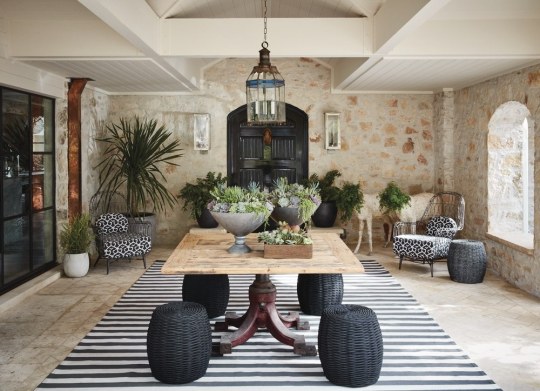
The home’s entry was designed to feel like an outdoor living space according to Santini, who sourced an 1850s English table and unusual Swedish lantern from the 1820s to anchor the room. The woven stools are from Tidelli, and the headless deer with ferns are by Italy’s Imperfetto Lab.

Architect Paul Lamb’s significant removal of walls led to a feel-good expansiveness where there are no boundaries. “It all kind of flows,” says Jensen. “You never feel like you’re in just one room.” In the media room, they did the least amount of work, painting the dark ceiling trusses to lighten the space and putting a German smear on the orange-y fireplace to tone it down.
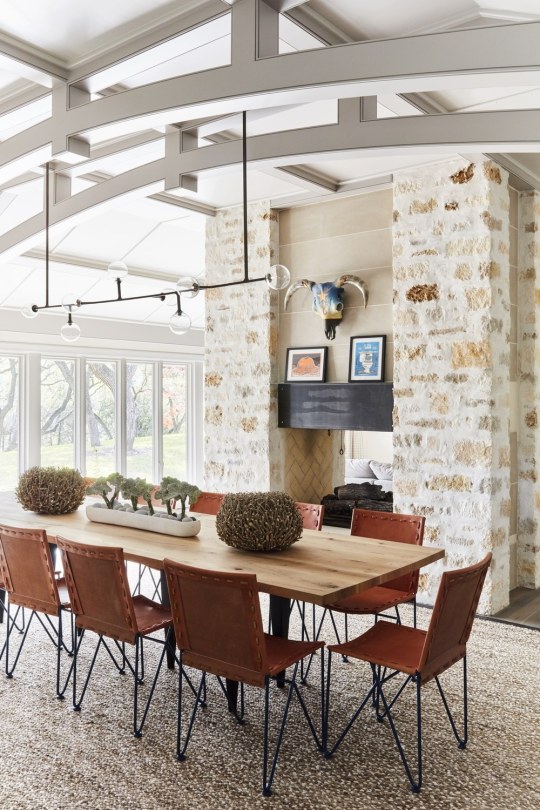
The most Texas room in the house is the Marfa-imbued dining space, where the couple’s cherished Boyd Elder bull skull hangs. It’s part of a 10-piece series from the ’70s, the most famous of which was on the cover of the Eagles’ Their Greatest Hits album. “Back in the ‘60s and ‘70s bands on tour wanted to have an artist with them, and Boyd was like the muse for the Eagles,” says Danneel, adding of the late artist, “I believe he dated Joni Mitchell, and she has one of the pieces.”

The slightly sunken living room with the deep-blue banquette couch, white shag rug, macrame chair, and muscular oak beams is Jensen’s favorite space. “There are just so many textures in that living room and vibrant colors, and it’s all surrounded by this amazing wood. I can just sit there and pick away at a guitar or play records all day long,” he says.
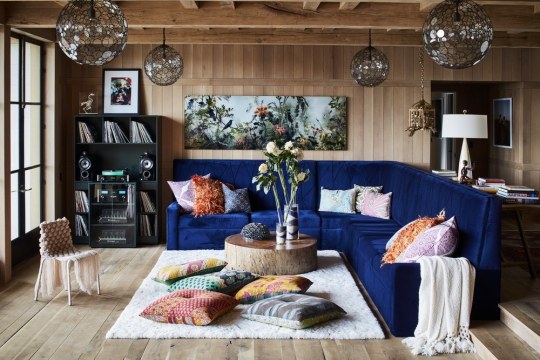
Behind the sofa is a gold birdcage artwork by Austin artist Micky Hoogendijk. It’s an observation on “women who seem to be trapped by money and possessions and they’re OK with it; they like living in that gilded cage,” says Danneel. “It looks intense but when you get close to it they’re all smiling and happy and unaware that they’re in this cage because they’re gold and perfect. For me that’s just somewhere I never want to be, so I was really attracted to that.”

Danneel spends a lot of time in the babies’ room (22-month-old twins Zeppelin and Arrow) and the kitchen, where the kids’ favorite toy is a rolling acrylic table from the ‘50s. (“Fern would have a heart attack,” she laughs.) They tore the space down to nothing and built it back from scratch. “It was a totally different feel, and very kind of country looking, which didn’t blend well with the rest of the house,” Jensen says. Now, to Lamb, “the kitchen’s glossy painted wood boards look like pinstripes, crisp and good-natured, like a happy kitchen in the Hamptons.”
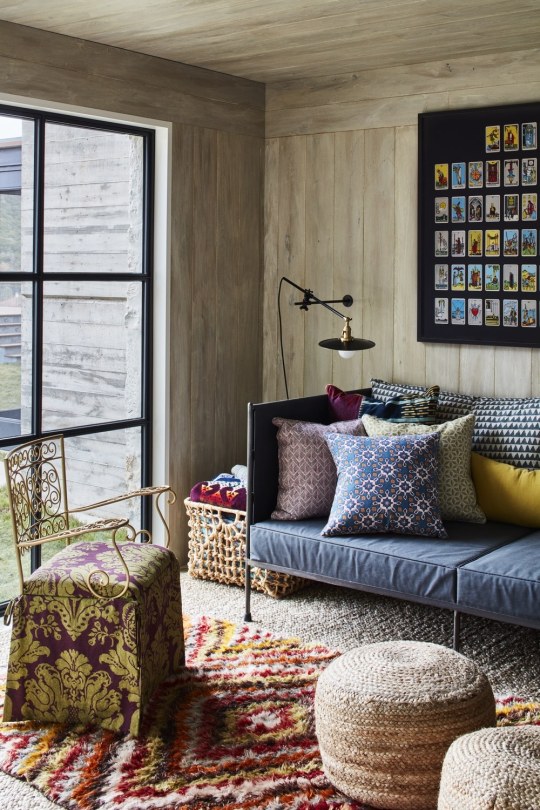
“There’s not a space they don’t use,” says Santini of the house she worked on with Jensen and Danneel. The reimagined pool room taps into their proclivity for spooky oddities with framed tarot cards and a game table that could work for board games or even séances, says Lamb, who added a secondary kitchen for big gatherings with access to a barbecue area on the lawn, and a wine room.
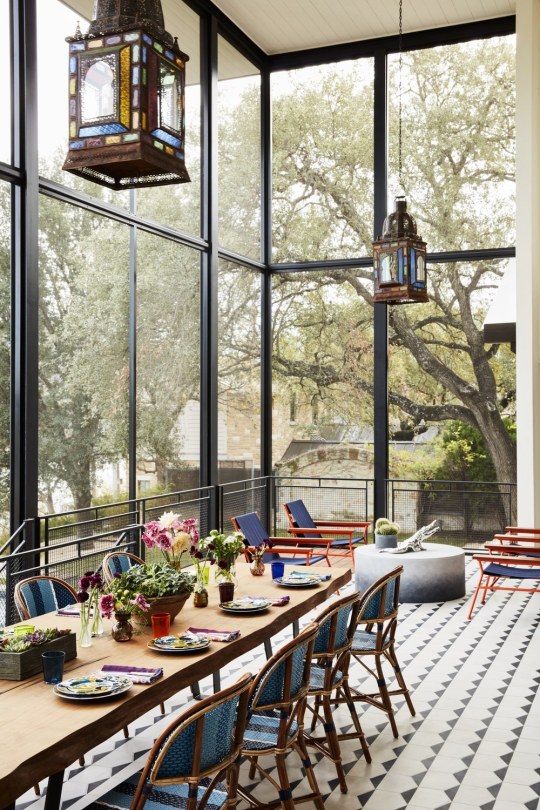
A native Southerner, Danneel fought hard for the addition of a screened-in porch, which Lamb had the vision—inspired by Greenwood Plantation in St. Francisville—to make two stories tall. “I wanted more than anything to be able to sit out there, not get eaten alive by mosquitos, and look at the lake and watch the boats go by,” says the actress. Jensen’s favorite piece in the house is the long table, custom made using a 2,000-year-old cypress log that had sunk and was buried on the West Bank of New Orleans.

The bar—black walnut with black and white veined marble—is on one end of the large living room and is the site of frequent small parties involving music, either live or from the McIntosh turntable. The cabinets were specially made to light prized bourbons, and on the side is a white taxidermy peacock Santini tracked down over months. Flooring throughout the house is hand-scraped Texas post oak with character to spare.
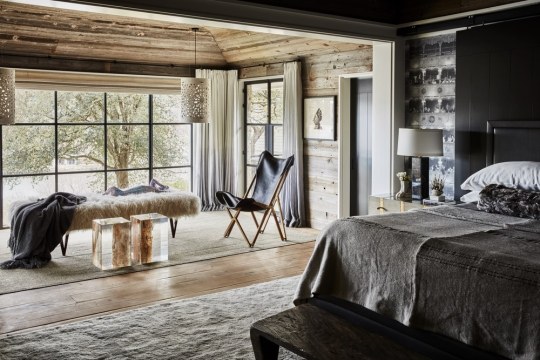
The master bedroom and the adjacent sitting room are clad in reclaimed barn wood, juxtaposing the whimsical wallpaper covered in sections by Japanese-inspired barn door panels that allow for flexible boundaries. Jensen said of the scheme, “You guys are losing me, but it sounds awesome, so knock it out!” Danneel already owned the two petrified wood and resin log tables that sit in front of the vintage ‘50s daybed with Mongolian lamb, though the majority of what’s in the home was selected or made specifically for it.
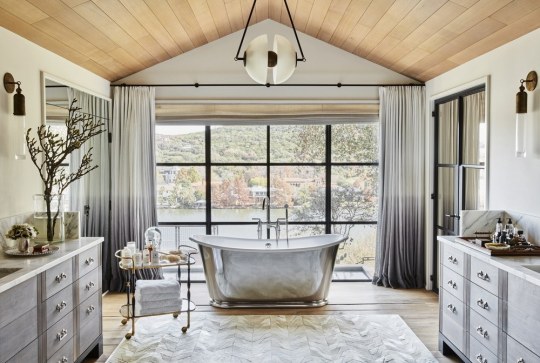
Inspiration for their master bathroom shower came from an Architectural Digest story featuring a steel and glass shower in the home of Neil Patrick Harris and David Burtka. Lit by Apparatus fixtures, Lamb conceived a simple vaulted space with a white oak board ceiling and fumed and cerused walnut cabinets with a slight Tansu feel. A Kyle Bunting cowhide rug is centered on the room, and Holly Hunt ombre-dyed handkerchief linen window treatments frame the lake view.
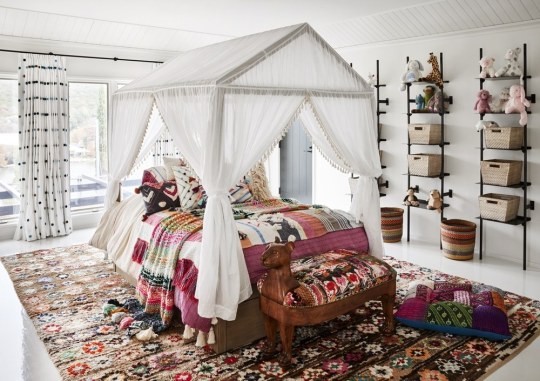
The pair’s five-year-old daughter, JJ, helped pick out all her own bedroom decor. “The more color the better,” says Danneel. Santini calls it “hippie in training.” Like in the rest of the home, her walls are plaster.

The ultra-private home looks out at a nature preserve across the water. Durable throw pillows around the house were made of old quilts purchased online. “We bought a lot of them and mixed them all up,” says Santini. “There’s nowhere in the house where you feel like you have to tip toe around or can’t sit. That was definitely intentional.”
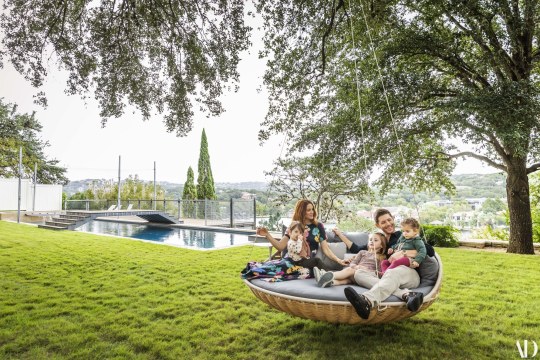
Inside and out, Lamb and Santini ensured that the Ackleses’ Austin home “expresses them—young, bold, and irreverent. It had to be full of humorous and endearing eccentricities and it needed to radiate a comforting yet exotic familiarity.”
architecturaldigest
#Jensen Ackles#Danneel Ackles#JJ Ackles#Zeppelin Bram Ackles#Arrow Rhodes Ackles#Ackles Home: Austin#Architectural Digest Photoshoot 2018#*#long post for ts
3K notes
·
View notes
Text
A QUICKIE COMPILATION
Of that Lapland adventure, I mean! 😉
First off:
Remember how I mentioned that it´s possible to run into Rudolph on the roads in Lapland?
Well...

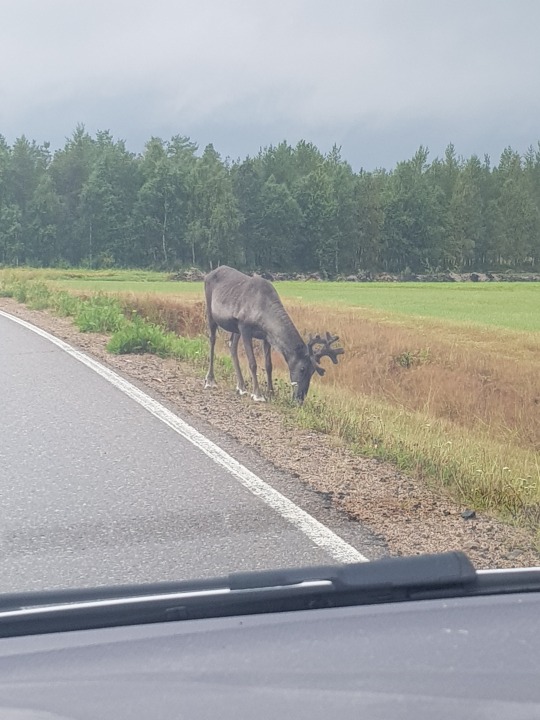
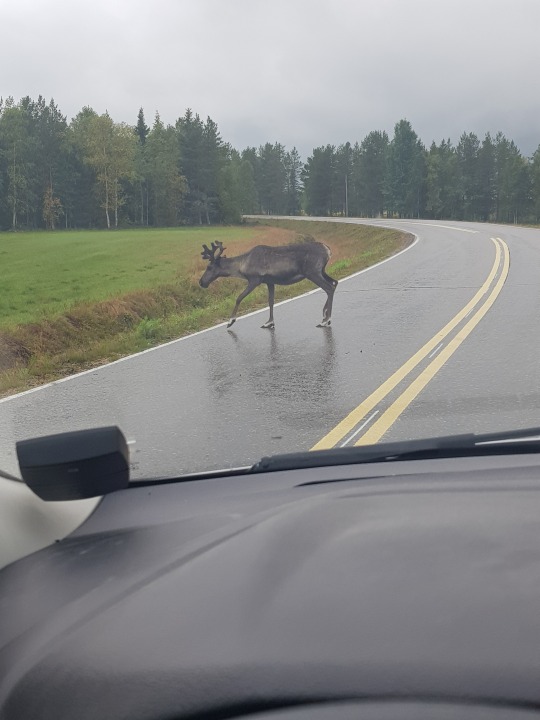
No chill, y´all. 🤷🏼♀️
After a while dude meandered off to join his flock.

Also: in case you cant a dead Rudolph on your wall or floor...
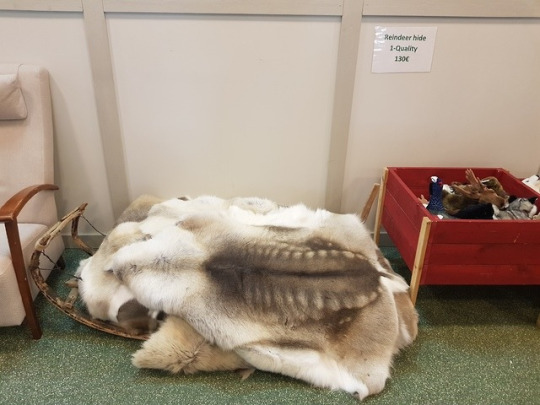
They got you covered! 🦌
And did you know that the arctic circle crosses over Rovaniemi?
Well, it does!

There it be. ✌️

Rovaniemi is also the official home of Santa, of course! 🎅

By ringing that bell, you can send your Christmas wishes directly to the bearded man´s office - or so the plaque promised...
I´ll be holding my breath until the 24th. 😜
We made a quick pitstop at Santa´s village...
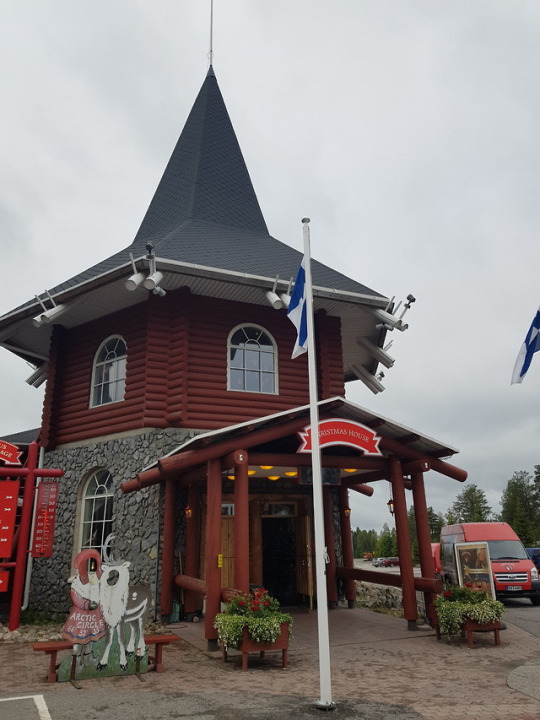
... and where Christmas carols were blasting from loudspeakers across every house and courtyard and in the middle of friggin´ AUGUST it kinda flipped my brain a little bit... 🤪
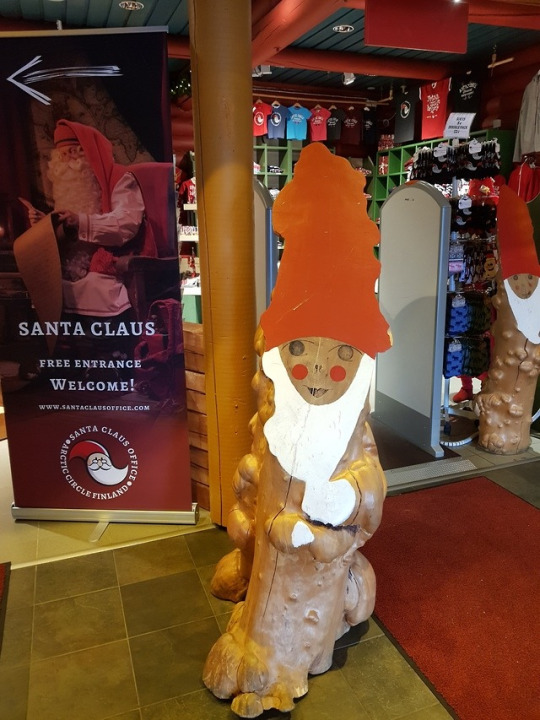
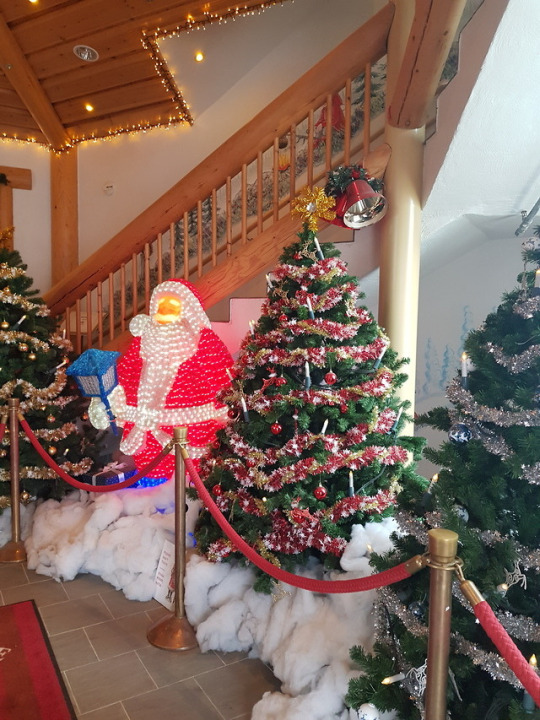
The “REAL” Santa was up there too, and if you paid 40€ (seriously FORTY EUROS!!!!), you could take a pic with him and get a nice holiday snapshot to send relatives for Christmas or whatever.
Me, being the cheapskate that I am, settled for a selfie with a lego version.
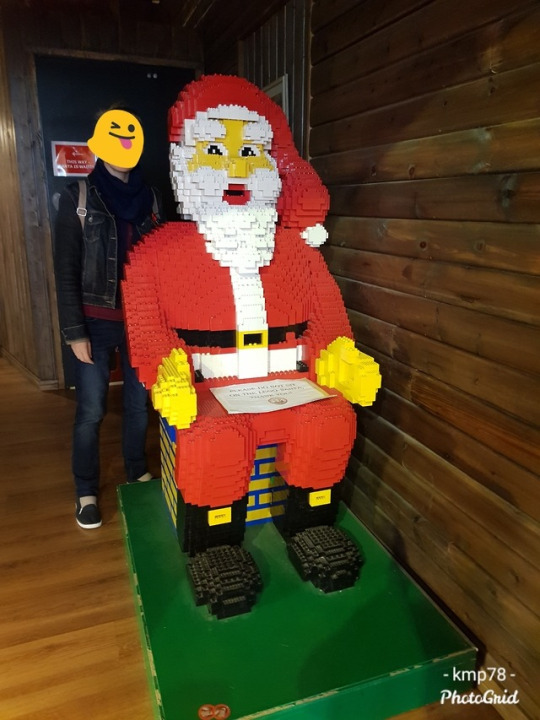
Ho ho ho and merry X-mas, bitches. 🙃
Also had to stop by Ranua Zoo since my last visit was back in the 80s so... why not?
And me being the berry nut that I am, I demanded a selfie with this kick ass cloudberry!
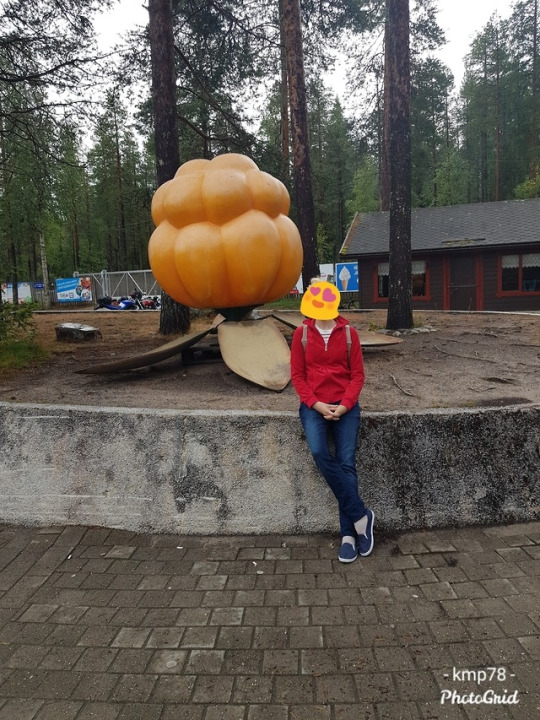
Saw my 1st ever polar bear...

...well, saw his back anyway.
I hope he was alive... 🤔
The brown bears were a bit livelier, altho this one broke my heart...

Her name is Jemma, and she was born here in the zoo, but soon after her birth her mom started attacking her and subsequently abandoned her completely. No one knows why...
The zoo staffers acted as her “mom” and raised her, and now she lives alone, separated from the rest of the bears in the zoo. 💔
The valley of the birds was my fave area in the whole zoo, the owls in particular were fascinating and soooo pretty! 😍
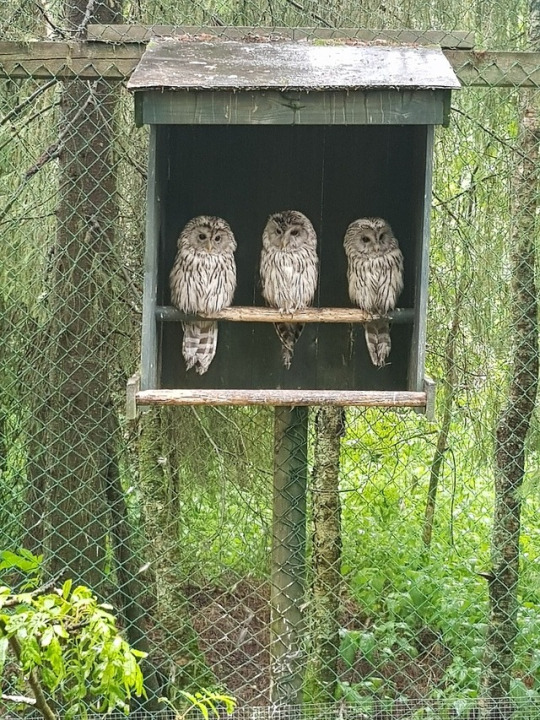
And in case you´ve never seen a moose breastfeeding...
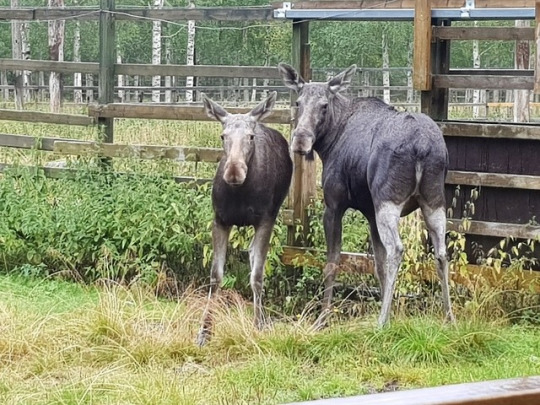
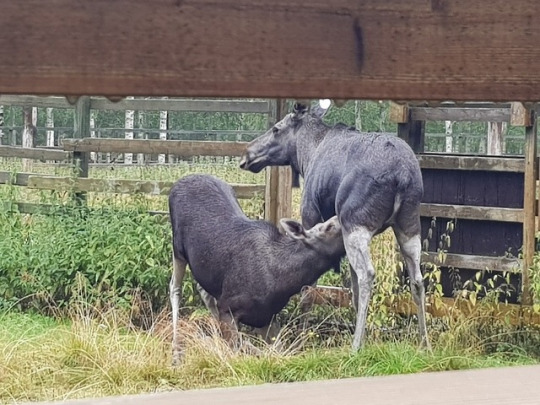
Eeeeeeewwwwww guyssssss... 🤢
And speaking of munching, I was kept happy with some Cajun chicken tacos in Rovaniemi...
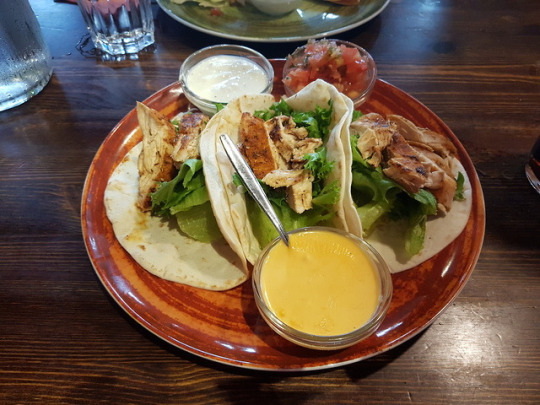
... and in Levi I went for the traditional reindeer stew but in burrito form!
I sh*t you not, folks! It had EVERYTHING the traditional version of the stew has (minus the mashed potatoes which were replaced by rice) but stuffed in a burrito! Rudolph meat, lingonberries, pickles...

FANTASTIC! Probably my fave food on the whole trip right there! 🤤
And reindeer also found its way into this little quiche pie.

Another traditional Finnish delicacy (if you can call it that cos it sure doesn´t look it...) was fried moose sausages and fried vendace at the Rovaniemi Olde Time Fair. Very tasty as well, if a slight bit rustic... Hehe. 🤷🏼♀️
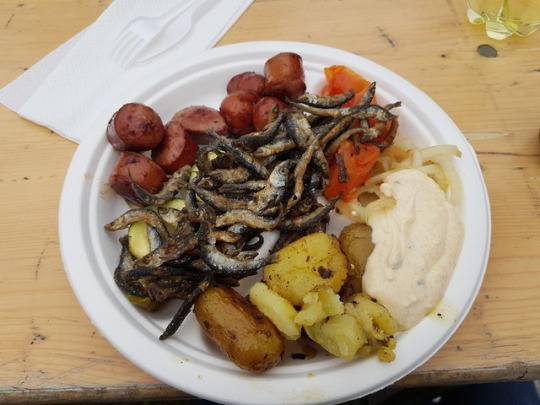
Anyway, the main destination for this trip was to visit my favorite Finnish artist´s home and atelier which is located in the middle of absolutely NOWHERE in Lapland.
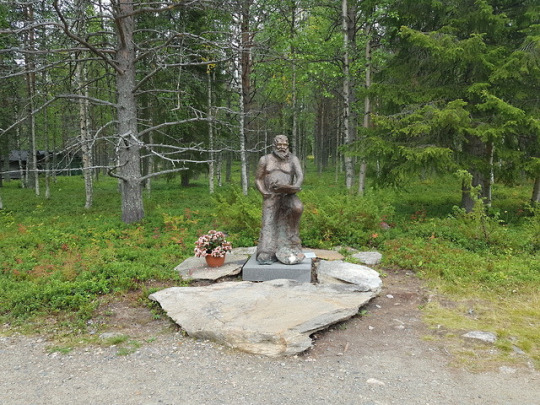
And yep once again on the 10 km dirt road leading up to his secret hideaway, Rudolphs were jumping all over the place...
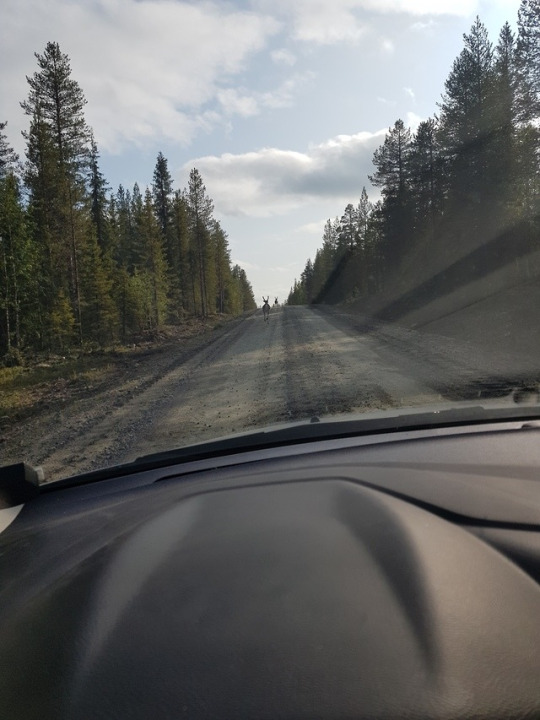

MoooooOOOOOOOVE!!! 😠
The artist in question, Reidar Särestöniemi, has been my #1 favorite for many years, not just for his quirky and mega-colorful paintings for which he took inspiration from both the vast and rugged Lapland nature surrounding his home...
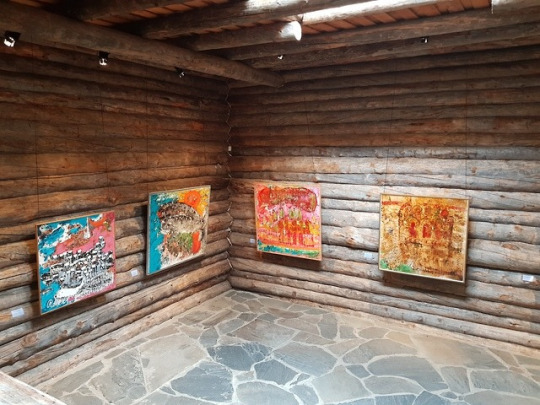
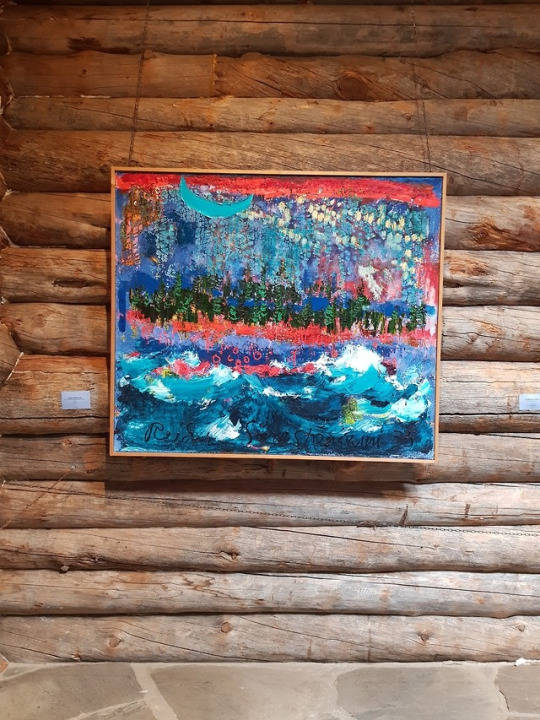


... but also for his life story.
What really moves me in many of his works is the fact that he was a homosexual, but as often was the case, he had to keep it a secret as back in his days in the 1950s - 1980s certain things just were not tolerated or openly discussed. In fact, during his lifetime homosexuality was still labeled as a crime in the Finnish justice system, so I can only imagine how tortured he must have been...😔
In his works, however, it´s kinda visible, like in this piece below.

“Seals in love”
To an outsider it may just look like two colorful fishes, but when you think of the man who painted it and the times he lived in and location where he lived in (I can only imagine what rugged Lapland “manly men” would have thought of homosexuality back then...), plus the fact that Reidar DID have a male companion (poet Yrjö Kaijärvi) who he was deeply and torturously in love with but could not publicly or openly admit it...
Well, the paintings take on a whole new meaning and you start seeing new depths in them.
I had dreamed of visiting his atelier for many years (it´s so far away from home that it probs was a once in a lifetime thing), and I have to say that I was not disappointed! The whole area was so calm and isolated and rugged... 😍
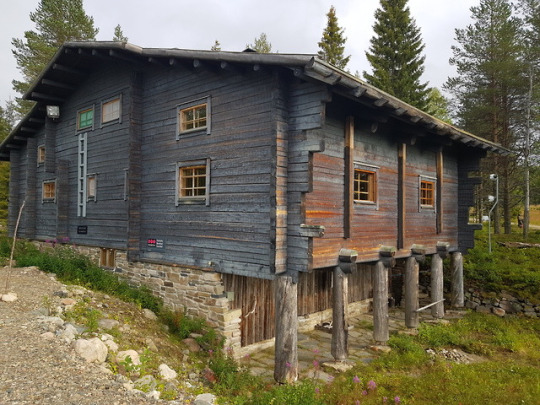
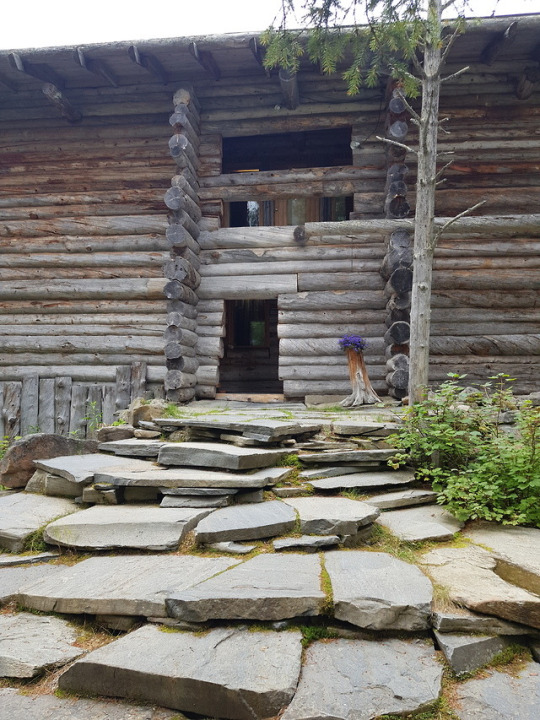
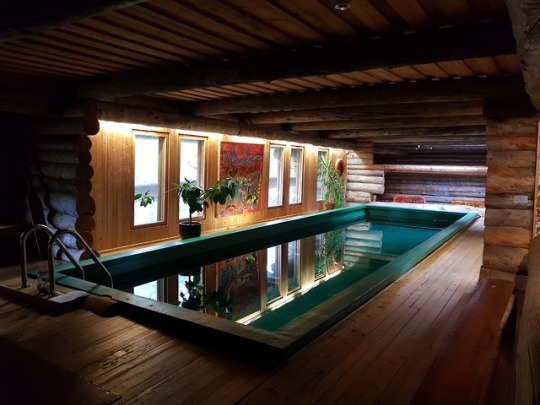
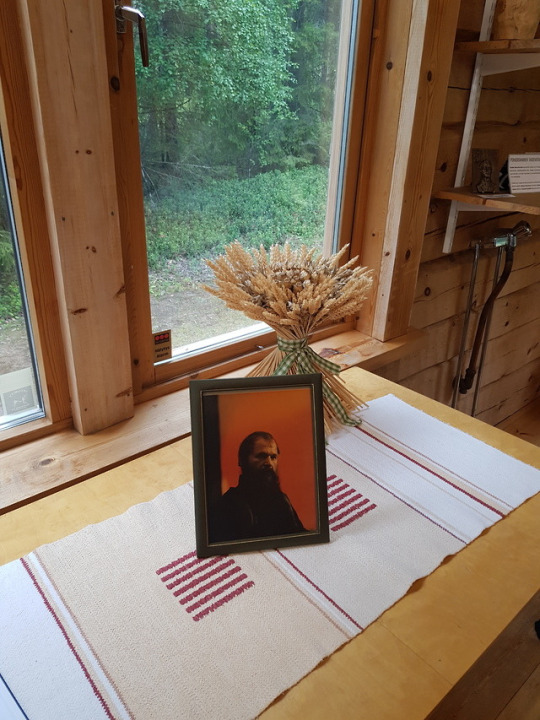
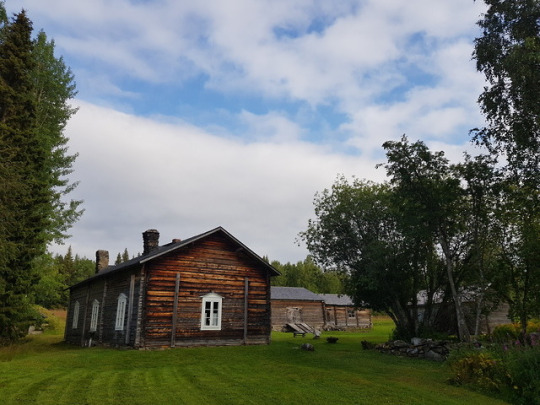
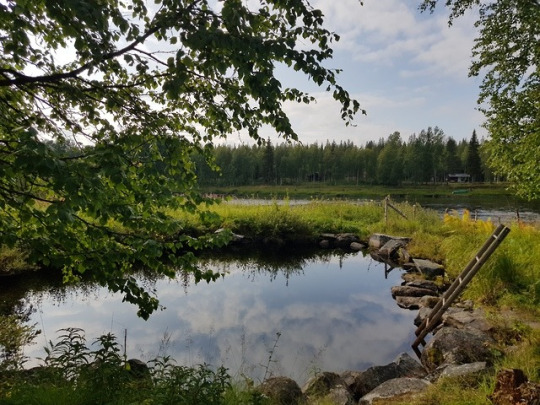
Heading still further north from Reidar´s home, we spent the night in Levi which is a popular ski resort in winter.
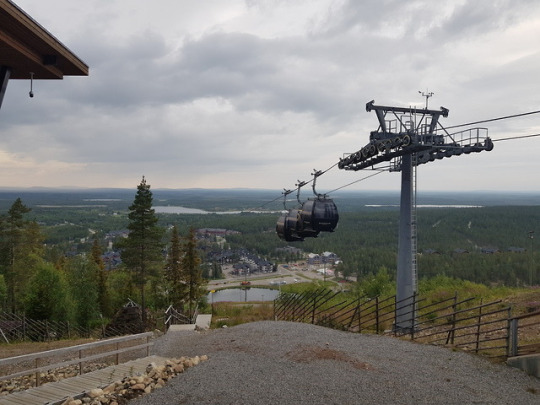
Btw our hotel room had a private sauna, and...
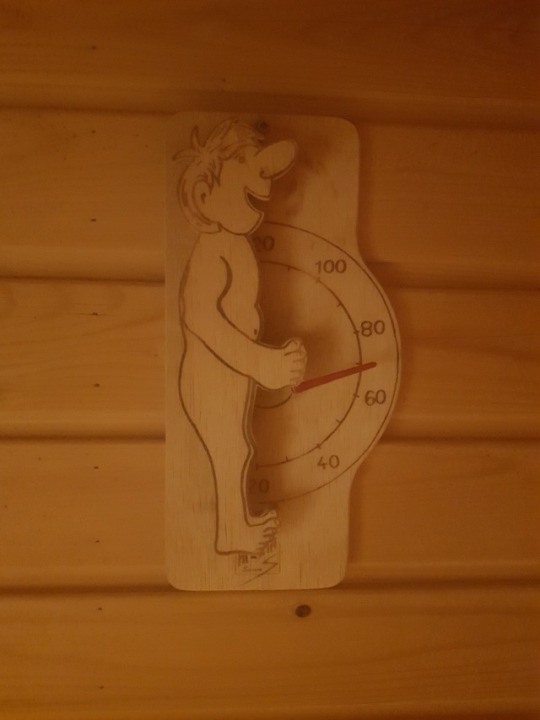
I tried to make it go all the way to 100. 😈
On the way down towards the south we swung across the border into Sweden, and stopped by a tiny town called Matarenki...
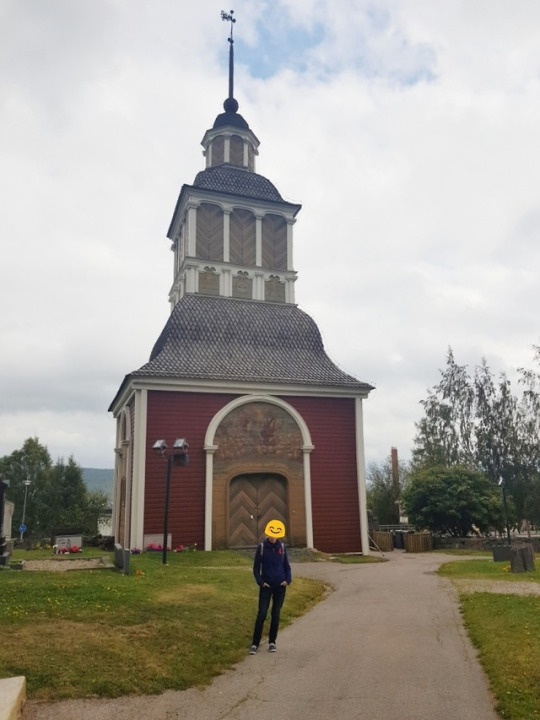
... and also in Kukkolaforsen.
It was fun driving down on the Swedish side of the border because all the way through you could see Finland on the other side of the river! 👋
I did feel a little homesick, I gotta say!

So close but soooooo faaaaaar... 😭
They do a lot of dip fishing here, on both the Finnish and Swedish sides.
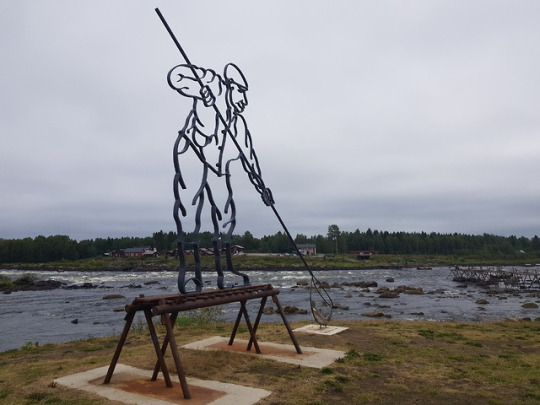

And if I may, I´d like to leave you with this little nugget of truthness I spotted in a store:
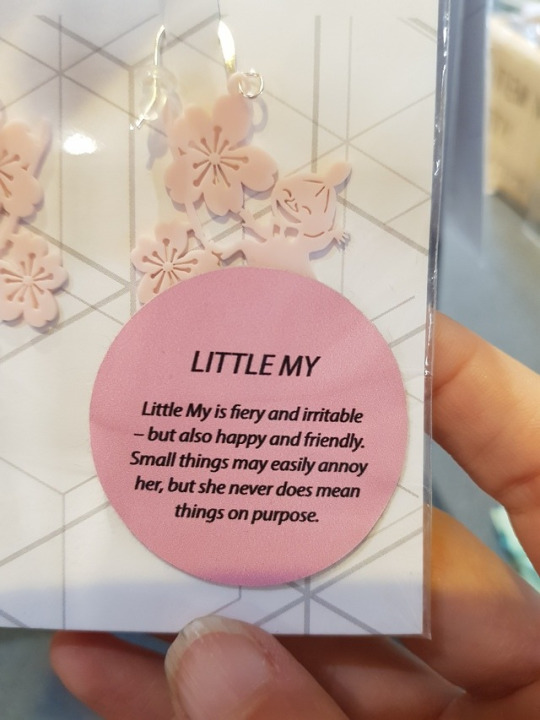
Oooooor... does she? 🤔
16 notes
·
View notes
Text
Commando.
Back on the road, for the better part of a day. Weather was going in & out of squalls and sunshine while we were threading the needle out and around Antwerp & through the Netherlands.
We had said goodbye to our Belgian family. We left Bert on the platz in Temse, Slien on a train back to Ghent. We stayed with our new friend Reit, in her giant house in Bazel, and in the morning after coffee, she and Filip, and even Ginger the dog all followed us to the van to wish us happy travels to Berlin.
The logistics of getting to Berlin, -the time and trouble of crossing a patch of land so broad, can’t be rectified with any schedule or budget. At different points within the planning stages of this trip we had a gig leading either to or away from the show in Berlin. But that’s not how it went down. Newly blessed with the luxury of a full day to drive, and the potential of a full day of leisure and exploration in a major European metropolis, we found ourselves rolling onto the Hasenhiede a little after 10 pm, ready to soak up all that this city could throw at us.
—
I walked the Via de la Plata for several weeks last year, before making the northern detour to the Camino Frances. The sparseness of the trail down south forced an immediate collegiality between the handful of walkers on the same itinerary. Many close bonds came out of spending weeks or more in the same space & taking care of each other.
When I took the left turn on the Camino Frances, I was slightly overwhelmed by the sheer number of pilgrims walking the trail. The small family vibe of Via de la Plata was replaced by the total anonymity of a large, moving city. But one day at a detour on the trail, I happened to fall in step with an english speaker, -a scottish woman named Kate. We had a brief chat & a coffee and parted ways, only to find each other again at the next cafe, where Kate invited me to continue together a bit longer.
On a busy, overpopulated superhighway of pilgrims of every stripe, I had been unable to gravitate towards anybody on the same page. But we walked for the entire day, talked about basically everything & ended up at a hippie vegan hostel out in the middle of nowhere. We had a shot of bad blended scotch in the one bar in town, and in the morning we parted ways, after exchanging numbers and taking a fuzzy snapshot.
Kate went back to Glasgow after she finished the Camino, but her wandering took her to Berlin. (you might have been wondering where I was going with this). When we parked the van on Hasenheide, and trudged down the street with guitars on our backs & suitcases in hand at 10pm, it was Kate’s sweet Scottish brogue that called down to us from a third floor balcony, and buzzing us in to our home away from Lövenich.
It was good to see her. It was late. She had a busy day tomorrow, so she couldn’t join us for a drink just now.
Ok, maybe just one.
Down past the Hermannplatz, past the weird mushroom sculpture, there’s a row of bars -every one of them way too hip for the likes of me. Especially when I’m holding a paper bag with three big pretzels in it.
Kate meshes in with the band immediately. It doesn’t seem to matter where you are from, if you have seen enough of the world, you’ll always find a point where your story overlaps somebody else’s. This was the beginning of a recurring theme in Berlin.
—
Morning was dark, overcast. The street outside was puddled and the trees were showing evidence of bluster. I had Dee Dee Ramone’s “Born To Die In Berlin” playing in my head. I wished I had some decent gloves.
We had instructions to get to the best local bakery/coffeeshop, the Albatross Bakeri. Enough beautiful shining croissants, uber-cool statuesque baristas, and rich espresso drinks to make the Herkimer look like a Tukwila Starbucks. We could barely get a table, it was like we stumbled into a movie set without knowing what our lines were, or even what the scene was.
Leaving the Albatross, we headed north to the canal where we stumbled across an open market that spanned three blocks along the water. Sherri bought some oranges. At the next bridge we crossed over & took a turn to the right. We were crossing under the rail line when I think Sherri & I both spotted an awning on a shop across the way, which had a very deliberate-looking CBGB resemblance. We were drawn in, cutting across the median to get a closer look at what turned out to be a museum of Ramones memorabilia -The Ramones Museum Berlin.
My path through music goes in a lot of directions, but the reason I am here is the Ramones. I grew up nowhere near NYC, and I never heard them until long after their heyday, but hearing the Ramones sealed my fate for basically the rest of my life. The mythical characters and the songs worked their way into my being.
In the back room of this coffeeshop in Berlin, we accidentally stumbled upon handwritten lyrics in Joey’s OCD scrawl. Early posters & photographs. Joey’s pants. The pinhead mask. Odds & ends that I could spend days studying.
Near the back of the first room was a worn out Ampeg amplifier & cabinet. -Dee Dee’s bass amp. Like, the amp that Dee Dee plugged into & stood in front of every night. Most of the numbers were worn off of the faceplate and a couple of the knobs had been replaced with Rickenbacker-style guitar knobs. I don’t get affected very often by musical instruments, and I am rarely starstruck, but standing there in front of Dee Dee’s amp, I felt actual chills. He was always too much of a mess to be a real kind of hero to me, his personal and addiction issues defined his image so much and I couldn’t relate to those parts of his persona. Dee Dee was the one guy in the band who was swept up by what he was doing, the real working artist in the band -the guy I have the most respect for. Still somehow it was always easier for me to commiserate with Joey’s internal neuroses than with Dee Dee’s self destruction, but I loved his songs. He was the dark cloud that balanced out Joey’s pop and rainbows. They were both uniquely poetic and silly as songwriters, but Dee Dee was what made the Ramones heavy.
We hung out in that place for about two hours. I had forgotten the strong tie between the Ramones & Germany, specifically Dee Dee and Berlin.
Only in this city could I leave a place like this, that hit me so far inside of my own identity and understanding, only to walk a few blocks and be in the shadow of something that was a ubiquitous menace to half of the world, for decades of the cold war. I don’t have the perspective to find even half of the emotions still contained in the stretch of Berlin Wall that currently hosts the East Side Gallery. The feeling is just as overwhelming standing there looking at an old bass amp as it is walking next to an old concrete barrier, but the difference is, here next to The Wall you can’t escape it. It’s not a feeling that you keep inside of yourself, and you can’t just step away from it. Somebody put this here, to keep people where they wanted them to be. A million different people have looked at this wall from both sides for decades and have felt a million different things. The energy directed towards this structure over the years is still palpable as you walk by it.
The Wall ends half way through a block, giving you time to reset your bearing with a few retail shops & some new construction. You’re feeling almost normal again as you reach the next canal to cross back. We paused at a photo booth, and I popped into a ranch-style compound to get a beer to share while the pictures developed.
—
Aimee & I headed up in the van to the venue. The tech rider from the club insisted that drums were not allowed, but we would see about that. The first band was already loaded in -just a 2-pc, but with tons of gear, mostly electronic. Aimee had a short conversation with the sound engineer when he showed up, and before I knew it we were loading in the snare & hats. We spent about 45 seconds on soundcheck & ceded the stage to the other band. The room sounds good, we know what we’re doing, we’ve got a ton of drink tickets in our pockets.
—
On the Via de la Plata there’s just a few cities that I can remember by name. Zamora is one of that I’ll always recall, because it’s a beautiful city, and also because that’s where I met Ina & Jenny.
Jenny lives in Hamburg, she’s the younger sister, and Ina, the slightly older sister lives in Berlin. We walked from Zamora to Benevente, with a zig-zag along the way, spending almost every night in the same houses for a little over a week & a half. They were the last remnants of the southern crew of walkers that I fell in with before I joined the Camino Frances, and we all took the last diversion to Benevente together before they departed the camino. They were a great team -I enjoy watching families interact with each other outside of their inner circle. They would walk together all day, arriving leisurely at the hostels late in the afternoon, still arm in arm. We shared lots of cervezas on the patios in the evenings with the other peregrinos, talking about what the world looks like from the shoes we’re in, while Ina would draw little masterpieces with pen & ink on little blank index cards. I still have two of her original creations on a windowsill at home. Geometric & ambiguous, evocative symbols waiting for you to affix an emotion to them. -to me they’ll always look like cool overcast evenings, that Tracy Chapman song, damp stone floors and news from back home, from when Steve was still with us. That’s a lot of weight for a few lines of ink to carry, but it’s all still there to this day.
—
We were sitting at a table upstairs at the gig, having a beer, when a hazel-blonde woman bundled in a felt cloak walked to a table across the room. She scanned the room as she unwound her scarf, and her eyes eventually settled on our table. It was Ina, looking exactly like the urban version of the pilgrim I met on the trail. Cooler in her general understatement than any of the precious hipsters in the joint.
The convergence of two emigrants from the upper Mississippi valley, one native of Oban, three peregrinos, two Berliners, and one child of the GDR settled in around our little table -Just me, Aimee, Kate & Ina.
I’m not an incredibly outgoing personality, in opening up & making friends out of strangers, but here we were, a gang of travelers loosely tied, all in the van, cranking Big Star while traversing the streets of Berlin, picking up Sherri on the way, imagining producer credits and guest star billing being superimposed on our windshield somewhere in post-production.
Back at the gig, we returned in time to catch the opening band. Heavy on the loops and reverb decay. Ina & me & Aimee sat in a row of stools in the back, enthralled by the not-so-subtle theatrics.
I like following a band so different than us. The room sounds so good, we were able to play it like another instrument. I could hear every nuance of our singing, and the guitar could get nearly silent, giving us plenty of headroom for building up when we needed to. The little room was nearly full, and the people gushed their approval after each song. When we finished, the first four dudes who approached me had their phones out asking “are you on Spotify?” -Berlin is not a place for sales of hard copies. But they ate up the stickers and I helped them all find us on their favorite streaming platform. The times they do change.
2am, the ranks had thinned down. Kate & Aimee & I were at the Burgermeister, eating burgers & fries we didn’t even know we needed. A dude walked up to us & says “excuse me, were you just playing music up the street earlier? I really enjoyed your music.” We’re huge with the Burgermeister crowd. Long day in Berlin, so many directions, so good.
0 notes
Text
Robert Frank’s Legacy: Nine Photographers Reflect
“When people look at my pictures I want them to feel the way they do when they want to read a line of a poem twice.” — Robert Frank
Robert Frank revolutionized documentary photography, embedding “the snapshot aesthetic” into visual culture. His boundary-breaking career spanned more than six decades, influencing generations of photographers and transcending genres.
Here, nine contemporary photographers reflect on how he and his seminal book, “The Americans,” had an impact on their work. Their comments have been edited for clarity and length.
Eli Reed
Eli Reed was the first African-American full member of Magnum Photos, joining the agency in 1988.
I met Robert Frank while covering a demonstration outside the 1984 National Democratic Convention in San Francisco. I was surprised that he was using a small, amateur 35-millimeter camera that could have disappeared inside my large hands.
I do not remember the conversation about that particular camera, my only thought being that I was inside a conversation with a man who helped me grab onto a ready-to-launch understanding of the importance of being inside visual truths for the right reasons and not advertisements for the self.
He was an ultimate truth seeker who laid pathways for others to follow. His lot was to do the work that would inspire and call to arms those willing to go forward into battle with a clear sense of what it takes to stand your visual ground with the photographs that were painfully truthful.
Justine Kurland
Justine Kurland is known for her utopian photographs of American landscapes and the fringe communities, both real and imagined, that inhabit them.
I’ve needed Robert Frank differently throughout my life — his Jewishness, his downtown-ness, his irreverence toward photographic convention. Once, when I studied at Yale, he arrived as a visiting artist. We all pinned our photographs to the wall for critique, and he admonished us for being safe and dull. “You have so much privilege,” he said. “You could do anything you want. And this is what you make? This?”
“The Americans” changed the possibilities of road-trip photography through radical subjectivity. Every picture is first and foremost a picture of Frank; it reflects an exterior world through the bias of an interior psyche: the view of Butte, Montana framed through his hotel curtains, the barbershop chair made visible through his silhouette on the plate glass window, the hitchhikers driving his car, with Frank the passenger.
But the picture I return to again and again traveling on road trips with my son during the first decade of his life is the last one in “The Americans.” Frank’s wife and son, Mary and Pablo, sleep inside the car on a shoulder of U.S. 90 in Texas. They slide unconsciously to the left, alone and vulnerable. I imagine sticky places on the seat beside them, and Cheerios ground into the floor mats, the sweet smell of gasoline and the sour smell of unwashed bodies.
Alec Soth
Alec Soth, based in Minneapolis, is known for his distinctive photographs of the American Midwest. He published his landmark monograph, “Sleeping by the Mississippi,” in 2004.
My initial attraction to Robert Frank was to the romantic wanderlust of his photographs made on the road. But as I got older, what I appreciated was Frank’s introspection. The camera’s eye is always pointed outward, but Frank’s vision encompassed his inner world — and his inner demons. “Life can be good,” he once said in an interview, “then you lie down, and stare up at the ceiling, and the sadness falls on you.” Frank taught me how to make a life out of looking — with honesty, both outward and inward.
Eugene Richards
Eugene Richards has undertaken assignments on topics including the American family, drug addiction, emergency medicine, pediatric AIDS, aging and death. The International Center of Photography exhibited a retrospective of his work last year.
Best as I can remember, I first saw “The Americans” in the early 1970s, right after I got back from working as a social worker and reporter in the Arkansas delta. I was unemployed, carrying around pictures of impoverished sharecroppers no one wanted to look at, not to mention flat out depressed by the ongoing Vietnam War and the growing social divisions in the United States at that time.
Hard to explain. “The Americans” — not one or two or three pictures, the whole of it — pushed me back out on the streets. Once derided as crude and un-American, now lauded as a masterpiece, the old book had me wanting to take pictures again, had me speaking out again, even when I figured almost nobody would be listening.
Ruddy Roye
Ruddy Roye has photographed ordinary people and their sometimes gritty lives for over a decade, inspired by his homeland, Jamaica. He is well known for his unflinching documentation of the black experience in America.
I might be one of a very few photographers who will openly say that I was not influenced at first by Robert Frank’s images. In fact, I came to them very late in life, and when “The Americans” literally fell in my lap, I remember leafing through its pages very confused. Except for a few of the images, I found myself questioning why some of them were even published.
What changed my mind was thinking of him as an “outsider.” I began looking at his images differently, as images that told a larger story as opposed to a one-off. For the past 10 years I have documented my America using both words and images to paint a theme of how I see the country that I have been living in for more than 20 years.
Robert Frank had the courage and foresight to use his blinders as an outsider to make a visual statement about his “America” that changed the way the whole world looked at this country. I can only hope.
Nina Berman
Nina Berman’s wide-ranging work looks at American politics and resilience. Her 25-year-long project “An autobiography of Miss Wish,” collaboratively documented one woman’s struggle with addiction, abuse, and recovery.
I started photographing Times Square in the early 1990s, inspired by Robert Frank’s “The Americans.” I was looking at myths and dreams, the promise and lies of capitalism amid a landscape of rapid urban renewal. It was a time when Times Square was being transformed from a place where people lived out personal fantasies, sometimes sordid ones, to a place where corporations dictated those ideals and fantasies. I’d walked around with my Leica for days and years believing that maybe I would find a moment that meant something about that space, and that time, and the people who passed by looking and searching.
Most days I never made a picture, but sometimes I did, and my bar was always Robert Frank.
Joseph Rodriguez
Joseph Rodriguez was a New York City cabdriver for 10 years. He lost his first camera in a stabbing and mugging. Undeterred, he got new gear and photographed what he saw on the job.
Robert Frank’s “The Americans” was very much an influence on my early development as a photographer. What I admired about his sharp eye is how he looked into the underbelly of our American society using his Leica. Issues that have always resonated with me were race and class. His photograph of the African-American nanny holding the white baby is one that still speaks volumes to me today. I see the same images in my neighborhood in Park Slope, where I grew up. I made this photograph back in 1984 when I was on my way back home from work as a taxi driver.
Frank did a series of photographs from a New York City bus, which inspired me to do my taxi series. (“Taxi: Journey Through My Windows” is to be published by powerHouse Books in February.)
Elinor Carucci
Elinor Carucci is an Israeli-American photographer who documents the intimate day-to-day of her own life, including the highs and lows of motherhood.
Robert Frank. An artist. A genius. A father. An immigrant. A lover. A Jewish man. Someone with talent but with a sensitive soul. He made images that bring intellect and emotions, politics and human stories, analysis and feelings, together. All there, in his images.
I never asked myself if Robert Frank was one of the artists who influenced my work — if you are a photographer working today, you were influenced by Robert Frank. In 1995 I immigrated to America. It was a deeply challenging experience in many ways, but the first thing that hit me with pain was that I could not photograph in a country I didn’t know, with a culture and language that were foreign to me.
I turned to “The Americans” to look for comfort and inspiration.
I remember taking this picture. It was 2012. We went to Jerusalem to visit my grandfather, who was already very old and ill, and since we live so far away, my children were not very close to him. Again, I turned to Robert Frank’s work. The eye of the immigrant. The most sensitive eye. What he managed to see and to what depth! Maybe because of the pain of not fully belonging anywhere anymore once one leaves the paradise of belonging.
Jim Goldberg
Jim Goldberg is a photographer and artist based in San Francisco. He works with text and images, often forming long-term collaborations with his subjects.
Robert, I woke up to the news that you were on to your next adventure.
You gave me the vocabulary to understand this world, yet I can’t seem to find the right words now to stress how important the role you played in my life was.
I am me — or rather, we are us — because of your crooked-impressionistic-out-of-focus-rule-breaking vision. Your words and images are seared into me, dripping with ink, smudged and blurred. You exposed our falsehoods and truths with a poetic understanding.
You beatnik road loving punk. My friend and my mentor. I, too, am sick of goodbyes.
Sahred From Source link Arts
from WordPress http://bit.ly/2O32H4s
via IFTTT
0 notes
Text
Photoshoot with Isabeau, Artist & Illustrator
I ‘met’ Isabeau on Instagram a few years ago when she messaged me to say she’d seen me in the metro paper (with the WORST haircut I have ever had). We’ve kept in contact, had numerous coffee dates, and message each other daily. I remember discovering Isabeau’s work and just feeling like I had to shine a spotlight on her, I think what she creates is so beautiful, considering her Fine Art background. I messaged Isabeau to ask her if she’d be willing to be in Infinite magazine, and sure enough she almost bit my hand off for the chance. I feel like Isabeau would be such an interesting person to interview and feature, although I am aware that my connection with her might be ‘too easy’. I’m aware that people might think that I’ve opted for the easy way out interviewing someone I know, but I think given the circumstances of how we ‘met’, I would argue that actually this is an ideal, and very modern, way of networking and engaging with my interviewee’s. Also, as I know her and her work very well, I know I’ll be able to ask her questions which will showcase her story well. I've set to work emailing beau her interview questions, as she’s in her final year she said she’d be happier for this way as she rarely has time to leave her house or studio. I decided to ask the following questions:
1. I think back fondly to how we met Beau! United by Instagram I remember you messaging me to say you’d seen me in the Metro (with THE worst haircut I have ever had) and after numerous coffee dates, Brighton ventures and daily text messages we’ve remained firm friends since. Would you mind telling readers who you are, and what you’re studying?
2. What made you choose to study Illustration?
3. You and your course are both based in Brighton, how have you found the experience of living in this City?
4. What does Brighton mean to you?
5. You’re coming to the end of your degree, what areas of expertise have you discovered you enjoy and wish to pursue as a career?
6. I’ve always been fascinated by your work, watching you doodle away on coffee dates, has drawing always been a hobby of yours that’s come naturally?
7. Who or what would you cite as inspiration in regards to your work?
8. How do you wish to develop your work?
9. Would you mind talking me through a personal favourite of yours which you have created?
10. What is your preferred medium of creating? Do you like pen to paper or are you more digitally inclined?
11. Do you feel like the modules set within your course have enabled you to refine your work?
12. What’re your plans once you finish your degree?
13. If you were to tell someone who’s never visited Brighton your top places to go, where would you suggest?
14. Have you met fellow strong, creative females during your time in Brighton?
15. If yes, who?
16. Would you describe yourself as Feminist?
17. If so, is this something which is reflected in your work?
18. Lastly, what would be your advice to any women wishing to pursue illustration as a hobby/class/college/uni course?
With the questions sent off, I though it would be a good idea to conduct a photoshoot with Isabeau to coincide with her article. I created a Pinterest board to gather inspiration for the shoot, and to also send to Isabeau so she could see the direction I was after, as well as inputting any ideas she may have. I said to isabeau it would be ideal to capture her in her home environment, so I could photograph her comfortably with her work, as well as take some interesting photos that captured the essence of her.
This morning after my 8.30am Orthodontist appointment I set off to Isabeau's, coffee and croissants in hand, I spent a good few hours chatting with her and slowly snapping away. I started initially just taking little snapshots of her room, little details like her artwork on the wall, cranberry juice by the bed, Isabeau doing her make up, and then asked Isabeau if I could take pictures of her and her work. She has a huuuuuge canvas in her room which she recently completed, and I thought this might look quite nice visually to photograph. As the weather was so rotten the lighting was a little off I feel, so I then asked if we could move downstairs to the living room and felt like the lighting down there was slightly better. I moved furniture about (sorry Isabeau!) and also experimented with camera angles to get a variety of shots, some I’m not keen on looking over, but I feel that to have a good selection to choose from I need to be a little braver with shooting.
As I photographed Isabeau I also asked questions about her work to make her feel comfortable, and to also have a ‘natural’ feel to the photos that wasn't so posy. I think I spent roughly 2-3 hours at Isabeau’s, I would of been longer but I had to leave to meet Leticia who I was also taking pictures of today. I’m going to spent this evening looking over what I’ve shot, and perhaps thinking what images are strong enough to go with the interview.
0 notes